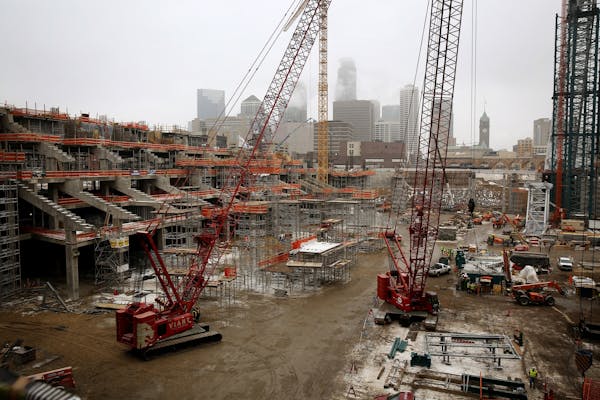The swelling footprint of the new Vikings stadium is bringing big changes to nearby city streets and the thousands of motorists who use them to enter and leave downtown Minneapolis.
The biggest changes will affect 5th and 6th streets near the $1 billion stadium rising on the east side of downtown. Fifth Street, a main artery carrying traffic from Interstate 94 into downtown, will close permanently about April 1. Sixth Street will be redesigned so that it keeps three eastbound lanes to funnel motorists to Interstate 94, but adds a single lane in the opposite direction to handle traffic coming off I-94.
"The realignment of a downtown street is fairly unusual," said Jeff Handeland, an engineer with the Minneapolis Public Works Department. "We did it with 5th and 4th streets with the Metrodome, and this takes it one step further."
In the coming weeks the Minnesota Sports Facilities Authority (MSFA) will buy the land, allowing work to start. A Minneapolis City Council transportation committee has endorsed the project.
The two sides have agreed on a price of $1.572 million to buy the land, move 5th Street and modify 6th Street, Handeland said. A small portion of 4th Street is also part of the deal.
Bicyclists also will be rerouted. The current bicycle lanes on 5th and 6th streets will be replaced with a two-way trail that will follow the current alignment of 5th Street and wind around the south side of the Vikings stadium. The trail will link up with other city trails and allow cyclists to ride around the new stadium.
Michele Kelm-Helgen, chair of the MSFA, said the aim is to encourage people to come to stadium events by bicycle. The stadium will have 189 bike racks with space for 378 bicycles. A Nice Ride station is also in the works, she said.
"We were very intentional to be as bike-friendly as we can," she said.
Driving into downtown
When 5th Street closes about April 1, the impact will likely be felt most by the 9,000 motorists who use the ramp from westbound I-94 to 5th Street each weekday. At 11th Avenue, most are expected to divert to 7th or 9th streets or use 11th Avenue to Washington Avenue S. to enter downtown.
A traffic analysis showed that adding one westbound lane on 6th Street would be sufficient to handle the 3,000 motorists expected to continue past the stadium, Handeland said.
The new alignment will have less of an impact on the 9,000 eastbound motorists who use 6th Street each day to leave downtown.
Curbside parking on the north side of 6th Street will be eliminated to make room for the westbound lane, which will be extended an additional block to Park Avenue S. Sixth will remain a one-way street in other areas of downtown, said Handeland.
Minneapolis plans to piggyback on the project to upgrade traffic signals in the area around the stadium with overhead arms and make other improvements, Handeland said.
"It's not just re-striping and putting in a new curb," he said.
Later, the Minnesota Department of Transportation plans to close the 5th Street ramp from I-94 and build a new off-ramp to connect drivers directly to 7th Street and create a straight shot to downtown.
That project is scheduled for 2016.
In the more immediate future, Metro Transit plans to build a pedestrian bridge at 4th Street and Chicago Avenue S. The bridge would carry pedestrians from the Downtown East light-rail platform to the Vikings stadium, Metro Transit spokesman Howie Padilla said.
Tim Harlow • 612-673-7768

Falcon Heights, St. Anthony move toward renewing police partnership severed after killing of Philando Castile
January assault on elderly man turns deadly, marking eighth homicide in St. Paul

Israel-Hamas war creates 'really fraught times' at Minn. colleges

Florian Chmielewski, former senator and Funtime Band accordion player, dies at 97

